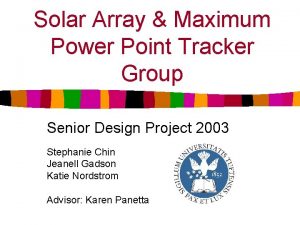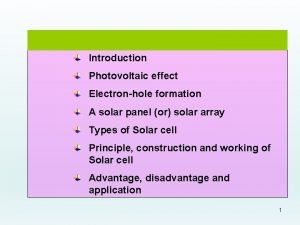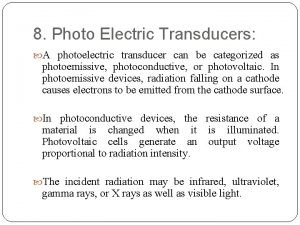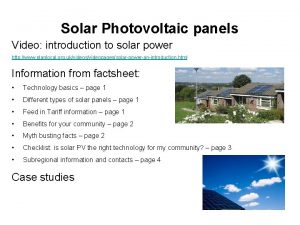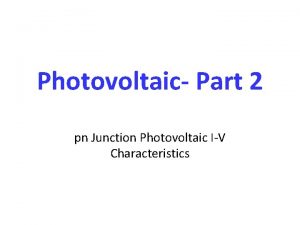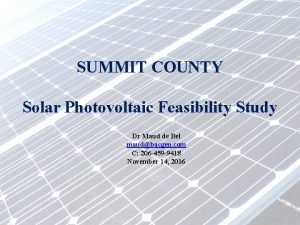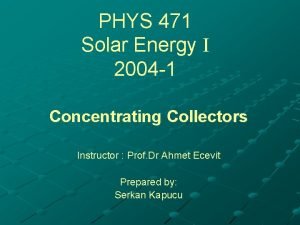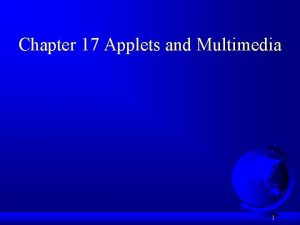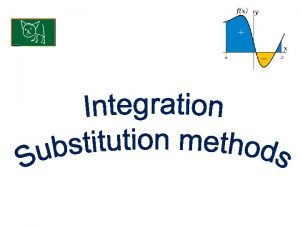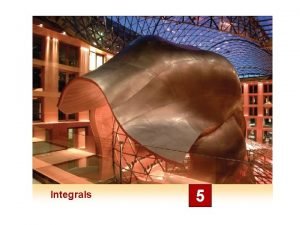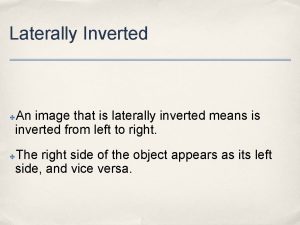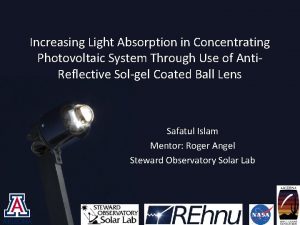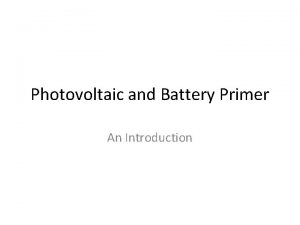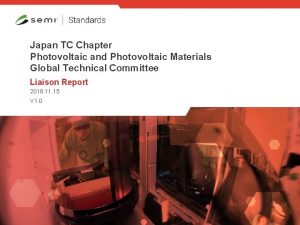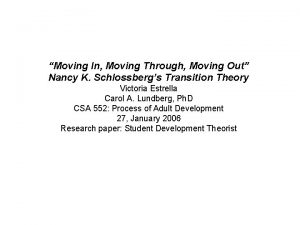Tracking integration in concentrating photovoltaic using laterally moving
















- Slides: 16

Tracking integration in concentrating photovoltaic using laterally moving optics HONGZHANG MA DEC. 12. 2013 OPTI 521 INTRODUCTORY OPTO-MECHANICAL ENGINEERING

Contents 1. Tracking-integrated concentrating photovoltaics 1. 1 Concentrating photovoltaics (CPV) 1. 2 Tracking-integrated CPV 2. Analysis of the Tracking-integrated CPV 2. 1 One relative movement between the optics and the receiver 2. 2 Two moving optics arrays and a solar cell array 3. Mounting issue and other existing tracking module 4. Conclusion OPTI 521 INTRODUCTORY OPTO-MECHANICAL ENGINEERING

1. 1 Concentrating photovoltaics ØConcentrating photovoltaic (CPV) systems employs optics to concentrate direct sunlight onto solar cells. Ø lower cost Ø high conversion efficiency OPTI 521 INTRODUCTORY OPTO-MECHANICAL ENGINEERING

Classification of the CPV systems Concentration ratio: The ratio of input and output aperture areas classification Concentration ratio (point) Solar cell Highconcentrating photovoltaics (HCPV) 400× multi-junction solar accurate dual-axis cells tracking Medium-concentrating photovoltaics (MCPV) Low-concentrating photovoltaics (LCPV) 10×~ 20× silicon solar cells (Or others) conventional silicon solar panels 2× ~ 4× OPTI 521 INTRODUCTORY OPTO-MECHANICAL ENGINEERING Tracker single- or dual-axis trackers maybe installed on a tracker, maybe NOT

Two examples of HCPV Reflective Refractive Common features: • concentrating optics + deployed solar cells are packaged as a concentrating photovoltaics module. • installed on an external solar tracker. Possible to remove the external tracker? OPTI 521 INTRODUCTORY OPTO-MECHANICAL ENGINEERING

1. 2 Tracking-integrated CPV a) conventional (stationary) CPV module with its acceptance angle α b) a tracking-integrated CPV module with the aperture angle αA of the optical system and the acceptance angle α for a particular direction Possible to keep the high efficiency as well as reduce the overall cost? OPTI 521 INTRODUCTORY OPTO-MECHANICAL ENGINEERING

2. Analysis about the Tracking-integrated CPV One laterally moving optics array and a solar cell array Two laterally moving optics arrays and a solar cell array (To reduce the complexity of the integrated tracking as well as the thickness of the overall CPV module the optics are restricted to lateral movement only) OPTI 521 INTRODUCTORY OPTO-MECHANICAL ENGINEERING

2. 1 One laterally moving optics array and a solar cell array Simultaneous Multiple Surface design method in two dimensions (SMS 2 D) is used to design the optics. SMS surfaces are piecewise curves made of several portions of Cartesian ovals that map initial ray sets to final ray sets. OPTI 521 INTRODUCTORY OPTO-MECHANICAL ENGINEERING

Example of a calculated meniscus lens for two parallel ray sets and design angles θ=± 10◦. (SMS 2 D) Within the aperture of the lens, the module obtains a 100× point concentration. But it is not sufficient to make use of high-efficiency solar cells. How? OPTI 521 INTRODUCTORY OPTO-MECHANICAL ENGINEERING

2. 2 Two laterally moving optics arrays and a solar cell array To properly evaluate the benefit from an additional moving lens array, the number of two curved optical surfaces should remain constant. Extended SMS 2 D algorithm used to design laterally moving optics. OPTI 521 INTRODUCTORY OPTO-MECHANICAL ENGINEERING

Offset x nd Optical axis receiver plane 1 st 2 2 Working distance W nd lens position p (SMS 2 D) Schematic drawing of a basic optical system consisting of two laterally moving lenses and a receiver plane. (Extended SMS 2 D) The final results are approximately 20× line concentration and 500× point concentration over the entire angular range. Is this the best way? OPTI 521 INTRODUCTORY OPTO-MECHANICAL ENGINEERING

3. Mounting issue and other existing tracking module Possible Mounting of CPV modules • Polar aligned single axis tracker Towards the South, tilt angle equal to the latitude, rotational axis equals the earth’s axis of rotation. • Horizontally aligned single axis tracker • Polar aligned stationary CPV module mounting • Horizontally aligned stationary CPV module mounting OPTI 521 INTRODUCTORY OPTO-MECHANICAL ENGINEERING

Existing tracking module 1. Micro-tracking CPV module - 300 x concentration ratio OPTI 521 INTRODUCTORY OPTO-MECHANICAL ENGINEERING

Existing tracking module 2. Spherical gradient-index lens 1000× concentration ratio OPTI 521 INTRODUCTORY OPTO-MECHANICAL ENGINEERING

4. Conclusion 1. General concept of tracking-integrated CPV and its potential of a lower overall cost. 2. Detailed benefit-cost analysis will be necessary. OPTI 521 INTRODUCTORY OPTO-MECHANICAL ENGINEERING

THANK YOU! OPTI 521 INTRODUCTORY OPTO-MECHANICAL ENGINEERING
 Photovoltaic array maximum power point tracking array
Photovoltaic array maximum power point tracking array Pereopods
Pereopods Frontal muscles of the body
Frontal muscles of the body Photovoltaic effects
Photovoltaic effects In photo image transducer electrons are attracted by
In photo image transducer electrons are attracted by Photovoltaic video
Photovoltaic video Wholesale solar power battery
Wholesale solar power battery Photovoltaic
Photovoltaic Solar leasing summit county
Solar leasing summit county Concentrating collectors types
Concentrating collectors types Forward integration and backward integration
Forward integration and backward integration Vertical integration
Vertical integration What is simultaneous integration
What is simultaneous integration Speed detection of moving vehicle
Speed detection of moving vehicle Moving ball program in java using applet
Moving ball program in java using applet Integral substitution
Integral substitution Integration using tables and computer algebra systems
Integration using tables and computer algebra systems
